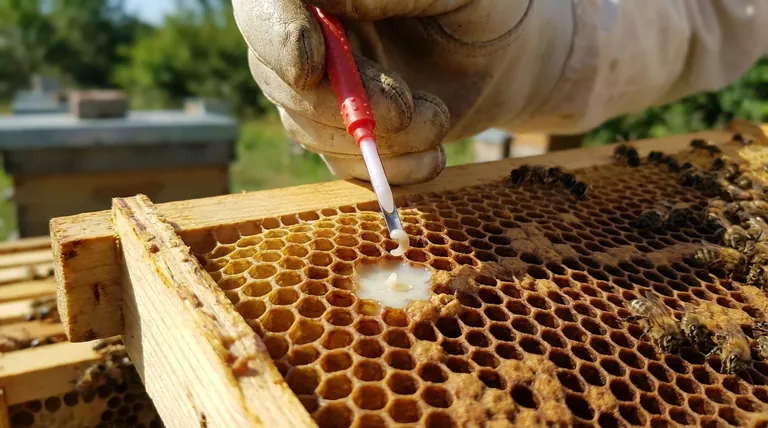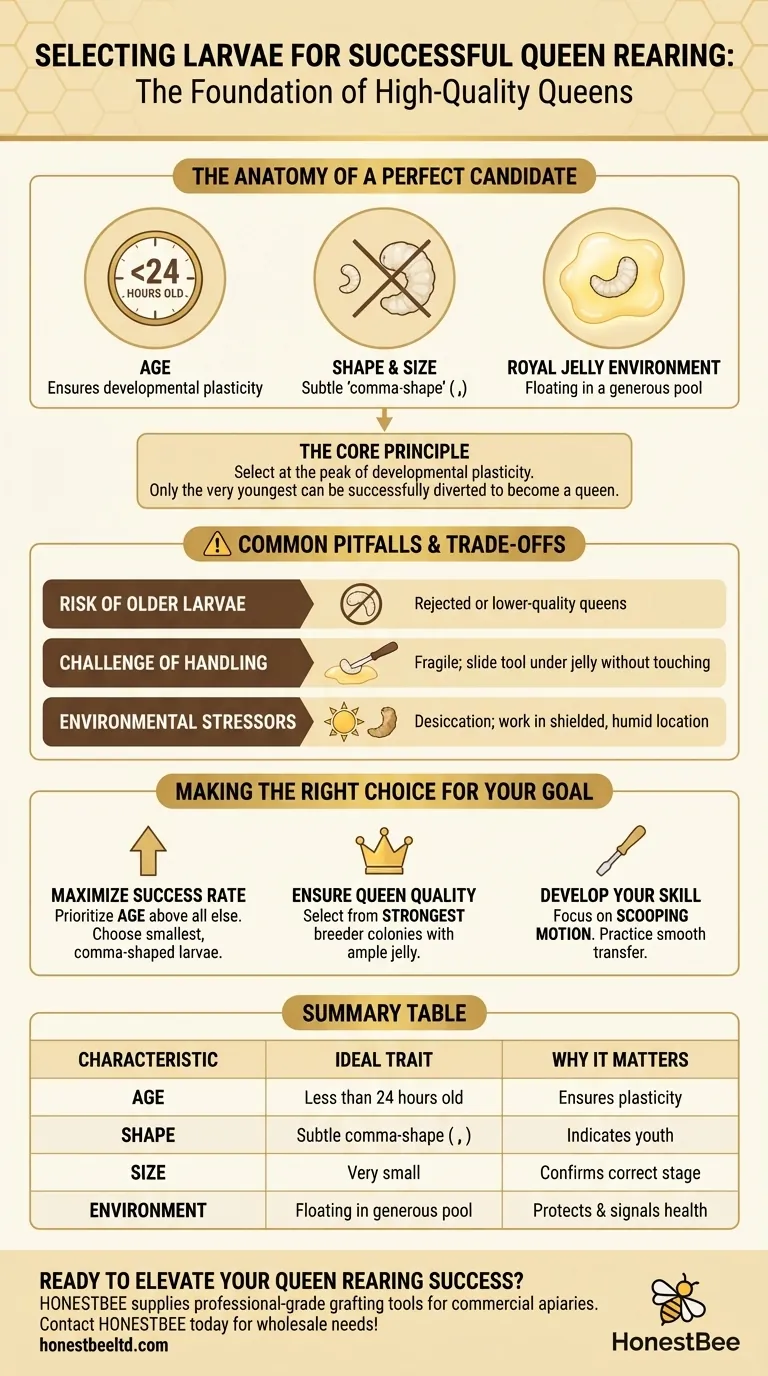To achieve successful queen rearing, the single most important step is selecting the right larvae for grafting. The ideal candidate is exceptionally young, barely visible to the naked eye, and is floating in a generous pool of royal jelly. These characteristics signal to the nurse bees that the larva is a viable candidate to be raised into a queen.
The core principle of grafting is not just moving a larva, but selecting one at the peak of its developmental plasticity. The age of the larva is the most critical factor, as only the very youngest can be successfully diverted from the worker path to become a queen.

The Anatomy of a Perfect Candidate
Identifying the right larva is a skill of observation. You are looking for a combination of age, size, shape, and environment. Getting any one of these wrong dramatically reduces your chances of success.
Age: The Non-Negotiable Factor
The larva must be less than 24 hours old from the moment it hatched from the egg. Larvae older than this have likely already begun differentiating into worker bees.
Choosing a larva of the correct age ensures it has the biological potential to develop into a fully formed, robust queen when placed in a queenless colony and fed exclusively on a queen's diet of royal jelly.
Visual Cues: Size and Shape
An ideal larva is very small, often just slightly larger than the egg it hatched from.
Its shape is a key indicator of youth. Look for a subtle "comma-shape" ( , ) or a slight C-curve. If the larva has grown into a more defined and larger "C-shape", it is too old for grafting.
The Royal Jelly Signal
A suitable larva will be floating in a significant pool of royal jelly. This indicates two things.
First, the larva comes from a strong, well-fed breeder colony capable of producing ample food. Second, this "raft" of jelly is essential for the transfer process, as it allows you to scoop the larva without touching it directly.
Understanding the Trade-offs & Common Pitfalls
While the goal is an 80-90% acceptance rate, many beginners struggle. This is typically due to a few common, avoidable errors during selection and handling.
The Risk of Older Larvae
Grafting a larva that is too old is the most frequent mistake. These larvae are often rejected outright by the nurse bees in the cell-builder colony.
Even if an older larva is accepted, it will likely result in a smaller, lower-quality queen because it spent its first day or two on a different developmental track.
The Challenge of Handling
These young larvae are incredibly fragile. The grafting tool must be slid under the royal jelly and the larva, following the curve of the cell, without making direct contact with the larva's body.
Disturbing or injuring the larva, or flipping it over during the transfer, will almost certainly result in its rejection.
Environmental Stressors
Larvae desiccate, or dry out, very quickly when removed from the high-humidity environment of the hive.
Work in a location shielded from wind and direct sunlight. Have your equipment prepared so you can transfer the larvae from the breeder frame to the cell cups without delay.
Making the Right Choice for Your Goal
Your specific goal will determine where you focus your attention. A practiced hand can consistently achieve an acceptance rate of over 80% by focusing on these fundamentals. You can verify your success about 24 hours later by looking for a thin, smooth wax rim being built up on the edge of the cell cup.
- If your primary focus is maximizing success rate: Prioritize age above all else. Always choose the absolute smallest, comma-shaped larvae you can find.
- If your primary focus is ensuring queen quality: Select larvae only from your strongest, healthiest breeder colonies, identified by the generous amount of royal jelly fed to all their young.
- If your primary focus is developing your skill: Focus on the scooping motion. Practice transferring the larva and its bed of royal jelly smoothly and without disturbance.
Mastering larval selection is the foundational skill for consistently raising high-quality queen bees.
Summary Table:
| Characteristic | Ideal Trait | Why It Matters |
|---|---|---|
| Age | Less than 24 hours old | Ensures developmental plasticity to become a queen. |
| Shape | Subtle comma-shape ( , ) | Indicates youth; a larger C-shape means it's too old. |
| Size | Very small, barely larger than the egg | Confirms the larva is at the correct, young stage. |
| Environment | Floating in a generous pool of royal jelly | Protects the larva during transfer and signals colony health. |
Ready to elevate your queen rearing success? The foundation of a thriving apiary is high-quality queens, and it starts with the right tools and knowledge. HONESTBEE supplies commercial apiaries and beekeeping equipment distributors with the professional-grade grafting tools, cell cups, and equipment needed for precise, successful grafting. Our wholesale-focused operations ensure you get the reliable supplies your business depends on.
Contact HONESTBEE today to discuss your wholesale needs and equip your operation for superior queen production!
Visual Guide

Related Products
- Plastic Chinese Queen Grafting Tool for Bee Queen Rearing
- HONESTBEE Advanced Ergonomic Stainless Steel Hive Tool for Beekeeping
- Professional 3-Bar Frame Grip with Integrated Hive Tool
- Professional Dual-End Stainless Steel Hive Tool for Beekeeping
- No Grafting Queen Rearing Kit: System for Royal Jelly Production and Queen Rearing
People Also Ask
- What are the steps involved in the grafting process? Master Queen Rearing for Your Apiary
- What is the process of shaving the cells for grafting? Improve Queen Rearing Success with This Technique
- What are the steps involved in using a queen grafting tool? A Guide to Successful Queen Rearing
- What happens if a larva is grafted too late? Avoid Scrub Queens and Failed Rearing
- What environmental conditions are optimal for grafting? Master Queen Rearing with Perfect Hive-Like Conditions



















